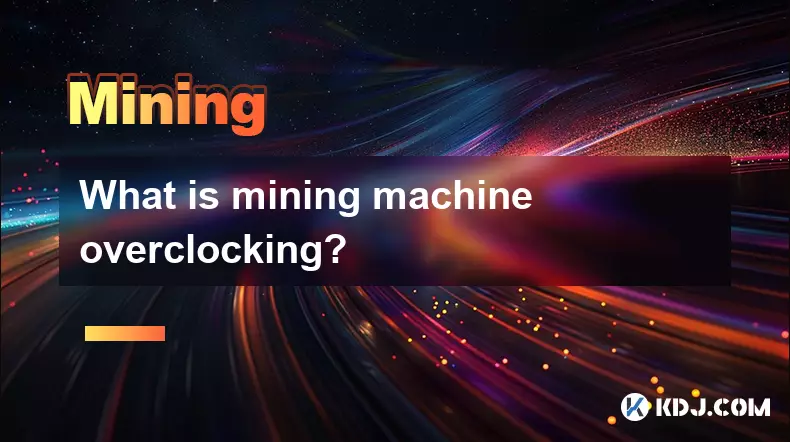-
 bitcoin
bitcoin $109523.663807 USD
-0.13% -
 ethereum
ethereum $4019.526508 USD
2.06% -
 tether
tether $1.000482 USD
0.00% -
 xrp
xrp $2.776815 USD
0.18% -
 bnb
bnb $958.942396 USD
0.12% -
 solana
solana $204.294698 USD
3.84% -
 usd-coin
usd-coin $0.999693 USD
0.00% -
 dogecoin
dogecoin $0.232115 USD
2.09% -
 tron
tron $0.338028 USD
0.84% -
 cardano
cardano $0.790920 USD
1.50% -
 hyperliquid
hyperliquid $44.871443 USD
5.60% -
 ethena-usde
ethena-usde $1.000322 USD
0.04% -
 chainlink
chainlink $21.034165 USD
2.60% -
 avalanche
avalanche $28.794831 USD
-0.54% -
 stellar
stellar $0.360466 USD
1.24%
How to build a mining rig from scratch?
Choose compatible hardware, ensure proper ventilation, install mining OS, join a pool, and maintain your rig for optimal performance and longevity.
Sep 11, 2025 at 09:54 am

Choosing the Right Hardware Components
1. Select a motherboard that supports multiple GPUs, such as models with AMD CrossFire or NVIDIA SLI compatibility. Look for PCIe slots to accommodate additional graphics cards.
2. Choose a high-wattage power supply unit (PSU) rated at least 80 Plus Gold to handle the energy demands of multiple GPUs. A 1200W or higher PSU is recommended for rigs with six or more graphics cards.
3. Pick a compatible CPU that won’t bottleneck the system, though mining primarily relies on GPU performance. An entry-level processor like Intel Celeron or AMD Ryzen 3 is sufficient.
4. Use a minimal amount of RAM—4GB to 8GB DDR4—as cryptocurrency mining software does not require large memory capacity.
5. Install a reliable storage drive, preferably a 120GB SSD, to run the mining OS and store configuration files efficiently.
Assembling the Mining Rig
1. Set up the motherboard on a non-conductive surface or inside a mining frame to prevent short circuits. Secure all components before powering on.
2. Attach the CPU, RAM, and SSD onto the motherboard following the manufacturer’s guide. Connect the PSU and ensure all power cables are routed safely.
3. Insert PCIe riser cables into the motherboard’s PCIe slots. These extenders allow flexible positioning of GPUs and improve airflow.
4. Connect each graphics card to a riser cable and secure them vertically or horizontally using brackets. Ensure GPUs are spaced apart for heat dissipation.
Proper ventilation is critical—overheating reduces efficiency and damages components over time.Configuring Software and Connecting to a Pool
1. Install a lightweight operating system optimized for mining, such as HiveOS, SimpleMining OS, or EthOS. These support remote management and auto-tuning.
2. Download and configure mining software compatible with your target cryptocurrency. Examples include Claymore’s Miner for Ethereum or CGMiner for Bitcoin.
3. Choose a mining pool based on fee structure, payout frequency, and server location. Popular options include F2Pool, Ethermine, and Slush Pool.
4. Enter the pool’s server address, port, wallet address, and worker name into the mining software configuration file. Double-check for accuracy to avoid rejected shares.
5. Launch the miner and monitor initial performance. Adjust GPU core clock, memory clock, and voltage settings to balance hashrate and power consumption.
Monitoring and Maintenance
1. Use built-in dashboard tools from the mining OS to track temperature, fan speed, and daily earnings in real time.
2. Clean dust from GPUs, fans, and riser cables weekly to maintain optimal airflow and prevent hardware failure.
3. Update BIOS, GPU drivers, and mining software regularly to benefit from performance improvements and security patches.
Always back up configuration files before making changes to avoid downtime during adjustments.4. Watch for sudden drops in hashrate or rejected shares, which may indicate failing hardware or unstable overclocks.
Frequently Asked Questions
What is the most profitable cryptocurrency to mine with a GPU rig?Ethereum Classic, Ravencoin, and Ergo are currently among the most profitable for GPU miners due to their ASIC-resistant algorithms and active communities.
How much electricity does a typical mining rig consume?A six-GPU rig can consume between 800W to 1200W under load. Actual consumption depends on GPU models, overclock settings, and PSU efficiency.
Can I use consumer-grade GPUs for mining?Yes, models like the NVIDIA RTX 3060 Ti, RTX 4070, and AMD RX 6700 XT are widely used in mining rigs due to their balance of performance and availability.
How do I protect my mining rig from surges or power spikes?Use a surge protector or an uninterruptible power supply (UPS) to safeguard components. Stable power delivery prevents unexpected shutdowns and hardware damage.
Disclaimer:info@kdj.com
The information provided is not trading advice. kdj.com does not assume any responsibility for any investments made based on the information provided in this article. Cryptocurrencies are highly volatile and it is highly recommended that you invest with caution after thorough research!
If you believe that the content used on this website infringes your copyright, please contact us immediately (info@kdj.com) and we will delete it promptly.
- XRP Tundra: Dual-Token Innovation in the XRP Ecosystem
- 2025-09-27 20:25:12
- MUTM: Is This Crypto the Smartest Buy Now?
- 2025-09-27 20:25:12
- Crypto Millionaires: Unlocking Financial Freedom with the Right Investments
- 2025-09-27 20:30:01
- ETH Price Check: Crypto Analysts Favor These Moves Now
- 2025-09-27 20:30:01
- BlockchainFX, Bitcoin Hyper, and Crypto Presales: Finding the Next Big Thing
- 2025-09-27 20:30:01
- Galaxy CEO, Bitcoin, and the Powell Replacement: A $200K Prediction?
- 2025-09-27 20:30:15
Related knowledge

The difference between staking and mining
Sep 24,2025 at 05:18am
Understanding Staking in the Cryptocurrency Ecosystem1. Staking involves holding funds in a cryptocurrency wallet to support the operations of a block...

How to participate in testnet mining?
Sep 22,2025 at 09:18am
Understanding Testnet Mining in the Crypto Ecosystem1. Testnet mining is a method used by blockchain developers to simulate real-world conditions on a...

How to dispose of abandoned mining machines?
Sep 19,2025 at 08:19pm
Assessing the Condition of Abandoned Mining Rigs1. Begin by inspecting each mining machine for visible damage, corrosion, or missing components. Machi...

How to identify high-quality mining pools?
Sep 21,2025 at 03:19pm
Reputation and Track Record1. A mining pool’s reputation is built over time through consistent performance and transparency. Pools that have operated ...

Advantages of decentralized mining pools
Sep 20,2025 at 04:36pm
Enhanced Security and Resistance to Censorship1. Decentralized mining pools operate on blockchain-based smart contracts, eliminating the need for a ce...

What is mining machine overclocking?
Sep 21,2025 at 07:19pm
Understanding Mining Machine Overclocking1. Mining machine overclocking refers to the process of increasing the operating frequency of a cryptocurrenc...

The difference between staking and mining
Sep 24,2025 at 05:18am
Understanding Staking in the Cryptocurrency Ecosystem1. Staking involves holding funds in a cryptocurrency wallet to support the operations of a block...

How to participate in testnet mining?
Sep 22,2025 at 09:18am
Understanding Testnet Mining in the Crypto Ecosystem1. Testnet mining is a method used by blockchain developers to simulate real-world conditions on a...

How to dispose of abandoned mining machines?
Sep 19,2025 at 08:19pm
Assessing the Condition of Abandoned Mining Rigs1. Begin by inspecting each mining machine for visible damage, corrosion, or missing components. Machi...

How to identify high-quality mining pools?
Sep 21,2025 at 03:19pm
Reputation and Track Record1. A mining pool’s reputation is built over time through consistent performance and transparency. Pools that have operated ...

Advantages of decentralized mining pools
Sep 20,2025 at 04:36pm
Enhanced Security and Resistance to Censorship1. Decentralized mining pools operate on blockchain-based smart contracts, eliminating the need for a ce...

What is mining machine overclocking?
Sep 21,2025 at 07:19pm
Understanding Mining Machine Overclocking1. Mining machine overclocking refers to the process of increasing the operating frequency of a cryptocurrenc...
See all articles









































































